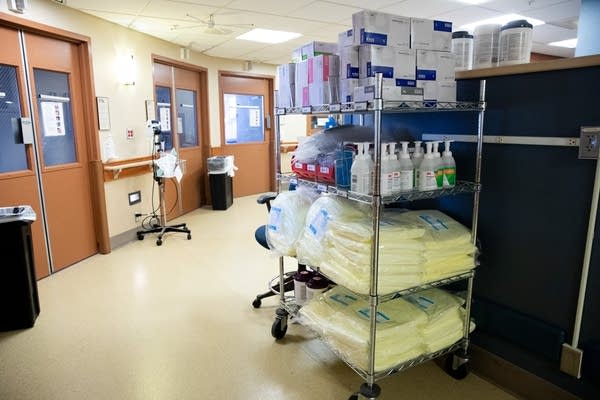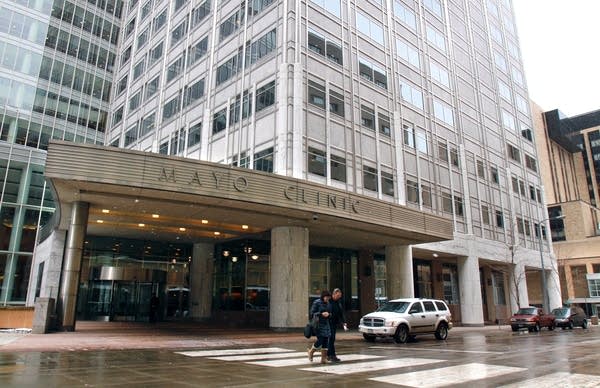Hospitals cut pay, furlough workers to ease COVID-19 financial blow

Go Deeper.
Create an account or log in to save stories.
Like this?
Thanks for liking this story! We have added it to a list of your favorite stories.
Updated: 6:07 p.m.
A few weeks ago, nurse Theresa Benson was helping people recover from surgery at Regions Hospital in St. Paul.
Then, Gov. Tim Walz ordered hospitals to stop doing elective procedures as a way to limit the spread of coronavirus.
With no surgeries, Benson suddenly had no patients to attend to.
"They told us they were going to close our unit, and that we were going to be staying home,” she said.
Turn Up Your Support
MPR News helps you turn down the noise and build shared understanding. Turn up your support for this public resource and keep trusted journalism accessible to all.
The decision to suspend noncritical care has come with an array of consequences because elective procedures are big moneymakers for hospitals. According to the Minnesota Hospital Association, abruptly stopping will cost hospitals statewide nearly $3 billion over the next three months. The association's president Dr. Rahul Koranne said significant federal funding is needed to help ensure Minnesota health care providers can make it through the pandemic.
The situation has forced hospitals across the state, from Mayo Clinic in Rochester to Essentia Health in Duluth, to implement significant cost-cutting measures.
The financial blow has trickled down to workers like Benson. She'll be paid half her full salary indefinitely.
In other places, idled health care workers are being forced to max out their paid time off, while others are facing across the board pay cuts.
Benson, who lives in Minneapolis, anticipates that she will be called back to work for a different unit. She understands why Regions stopped surgeries, and she's grateful to still have her job.
In the meantime, she filed for unemployment — money she still hasn't received.
Benson, a mother of five, says her job situation has created a swirl of financial uncertainty for her family.
"At the moment, I don't know what's going to happen. I don't know how we're going to pay bills that come up here in the next month,” she said.
According to the state employment department, more than 30,000 people who work in the health care sector had filed for unemployment as of this week.
When Mayo Clinic stopped elective services the last week of March, it lost $162 million for just that month, said Jeff Bolton, Mayo’s chief administrative officer. Losses through the end of the year are predicted to be $3 billion.
"And so we made decisions that were difficult decisions,” Bolton said.

Mayo is instituting hiring freezes, pausing construction projects, and laying off contract workers.
The health system will also cut pay and furlough staff in Minnesota, Florida and Arizona. Mayo has not said yet how many people will be furloughed or for how long.
Bolton said Mayo's executives will take a 20 percent pay cut immediately, while others — like physicians — will see smaller pay cuts starting in May.
Mayo's hourly workers will not see a reduction in their pay rate.
Even then, Mayo will face a $900 million shortfall at the end of the year, which it will cover using reserves.
At Alomere Health, a mid-sized hospital in Alexandria, it's a similar story.
"Basically, we're shutting down all the business lines that keep the doors open and keep the lights on within our facilities,” said hospital CEO Carl Vaagenes.
Halting elective surgeries and procedures, like mammograms, resulted in a 56 percent decline in revenue for April, Vaagenes said. To balance that, the hospital has cut back on hours and staffing.
But Vaagenes said the hospital also can't risk losing its entire workforce.
"We're balancing that with the fact that we're going to need all hands on deck at some point once the surge hits,” he said.
Some health workers argue that they're needed now, even if they're not caring for patients who have COVID-19.
A primary care physician who works for an M Health Fairview clinic in St. Paul is among those who are taking a weeklong furlough in April, which amounts to a 25 percent pay cut for the month.
She asked not to be named for fear of losing her job.
She said her week away from work could be harmful to some of her patients who are medically and economically vulnerable. If hospitals continue to cut back on services in response to the virus, it will mean fewer opportunities to catch preventable — but serious — conditions.
“I've had many phone calls this week and last week with my patients with mental health problems, having increased anxiety, difficulty sleeping, more depression,” she said.
“Being able to hear that familiar voice of your provider is really more important now more than ever,” she added.
Editor’s note: Reporter Catharine Richert is married to a Mayo Clinic physician who will be affected by these pay changes.


